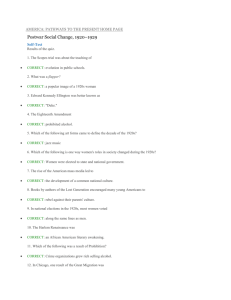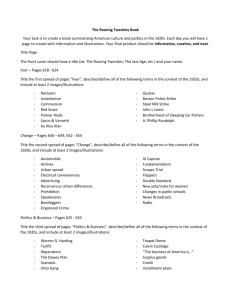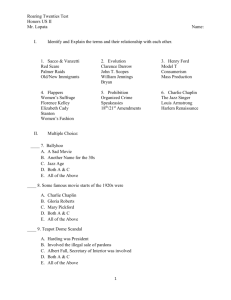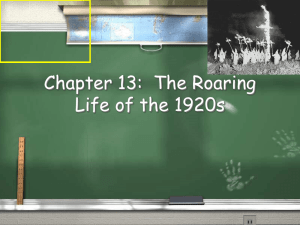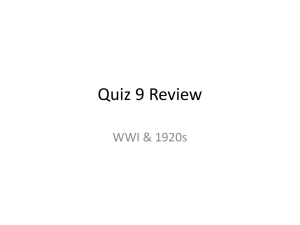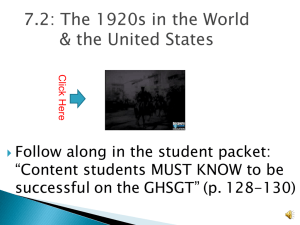TEACHER: CLASS: 5th Grade DATE: February 29
advertisement
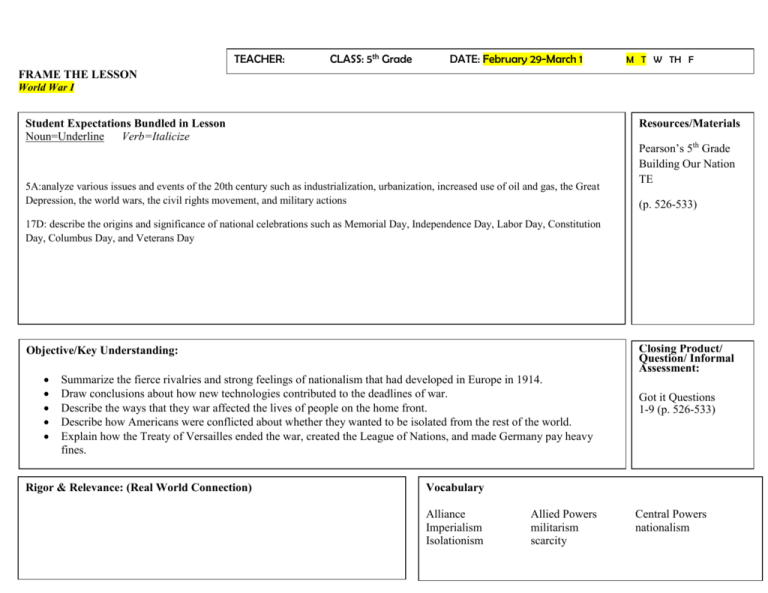
TEACHER: CLASS: 5th Grade DATE: February 29-March 1 M T W TH F FRAME THE LESSON World War I Student Expectations Bundled in Lesson Noun=Underline Verb=Italicize Resources/Materials 5A:analyze various issues and events of the 20th century such as industrialization, urbanization, increased use of oil and gas, the Great Depression, the world wars, the civil rights movement, and military actions Pearson’s 5th Grade Building Our Nation TE (p. 526-533) 17D: describe the origins and significance of national celebrations such as Memorial Day, Independence Day, Labor Day, Constitution Day, Columbus Day, and Veterans Day Objective/Key Understanding: 5C Summarize the fierce and strong feelings nationalism that had developed in Europe in 1914. identify the accomplishments of rivalries individuals and groups such asof Jane Addams, Susan B. Anthony, Dwight Eisenhower, Martin Luther conclusions about how new D. technologies contributed to the deadlines of war. King Jr.,Draw Rosa Parks, Cesar Chavez, Franklin Roosevelt, Ronald Reagan, Colin Powell, the Tuskegee Airmen, and the 442nd Describe theTeam wayswho thathave theymade war contributions affected the to lives of people on the front.women's rights, military actions, and Regimental Combat society in the areas ofhome civil rights, Describe how Americans were conflicted about whether they wanted to be isolated from the rest of the world. politics Closing Product/ Question/ Informal Assessment: Got it Questions 1-9 (p. 526-533) Explain how the Treaty of Versailles ended the war, created the League of Nations, and made Germany pay heavy fines. 13E Rigor & Relevance: (Real World Connection) Vocabulary explain the impact of American ideas about progress and equality of opportunity on the economic development and growth of the United States Alliance Imperialism Isolationism Allied Powers militarism scarcity Central Powers nationalism Stop and Check for Understanding- High Level Questions Conflict in Europe (p. 526-527) When do you think the Great War came to be called the First World War? Why would a country enter into an alliance that required it to defend other members of the alliance? Why did Iberian nationalists want to assassinate Archduke Ferdinand and his wife? How did Austria-Hungary respond to the archduke’s assassination? The War Begins in Europe (p. 527) How did alliances, imperialism, militarism, and nationalism contribute to World War I? What did it mean when Russia said it would defend Servia if it were taken today? What did it mean when Russia said it would defend Serbia if it were attacked? The United State Enters the War (p. 528-529) Why did Americans not want to get involved in the war at first? What was the Zimmerman Note? Why do you think it was important for troops and military leaders to write messages that were not easily decodable by the enemy? Why do you think the United States did not want Mexico to join the Central Powers? How did the sinking of the Lusitania promote American involvement in the war? Trench Warfare (p. 529-530) What is a trench? What is a bayonet? What caused soldiers to begin to wear gas masks? Why did soldiers on the ground use trenches? Why were the trenches harsh places to wage war? What were some of the effects of poison gas used in war? Why do you think the area between the opposing armies’ trenches was called “no-man’s land”? New War Technologies (p. 530) Why do you think Americans and the British called German submarines U-boats? How much time passed between the invention of the airplane and using it to drop bombs? The invention of the machine gun brought about the invention of what other weapons? How were airplanes used during the war? What were German submarines called? What nation invented the tank? How were tanks used? On the Home Front (p. 531) During the war, half a million African Americans and a million women entered the workforce. Why were so many people able to find jobs? What do you think happened to those people when the war ended? How did people in the United States respond to food shortages? Why types of work did people do on the home front to help with the war? How did the war affect job opportunities? Why would a family in the United States make a victory garden, and how do you think that helped the war effort? How do you think President Hoover’s promotion of “meatless Mondays” and “wheatless Wednesdays” helped the country to adapt to wartime? Costs of the War (p.532) What is a bond? What is interest? In what two ways can the cost of the war be expressed? Why do you think the Allied Powers were able to win the war with America’s help? What does the fact that the Central Powers surrendered say about the strength of the Allied forces? The Treaty of Versailles (p. 532-533) How did the Treaty of Versailles treat Germany? What modern-day organization is similar to the League of Nations? Why did the United States not sign the Treaty of Versailles? What officially ended the war? Engage Explore Explain Elaborate Evaluate Introduce Key Idea & Vocabulary (p. 526) Read to the class the Key Idea: “I will know the causes and effects of World War I.” Tell students in this lesson they will be learning about this quote and what it means to American History. Go online to access the Lesson Introduction and discuss the Big Question and lesson objective (p. 526). Students are to complete the Using the Words to Know Worksheet before reading the lesson. Remind students that they will know the causes and effects of World War I. Conflict in Europe (p. 526-527) The War Begins in Europe (p. 527) The United State Enters the War (p. 528-529) Trench Warfare (p. 529-530) New War Technologies (p. 530) On the Home Front (p. 531) Costs of the War (p.532) The Treaty of Versailles (p. 532-533) Remind students that they will know the causes and effects of World War I. Conflict in Europe (p. 526-527) Alliances were a key cause of the war. An alliance is an agreement among nations to defend each other. In World War I, the main alliances were the Allied Powers and the Central Powers. Great Britain, France, and Russia were the Allied Powers. Germany, Austria-Hungary, and the Ottoman Empire were the Central Powers. The members of each alliance were allies. They promised to defend any other members of the alliance who was attached. The War Begins in Europe (p. 527) The assassination of the archduke and his wife led Austria-Hungary to make strong demands on Serbia and promise punishment if the demands were not met. Russia then said that it would fight Austria-Hungary if Serbia was attacked. Then Germany declared war on Russia and its ally, France. Great Britain then joined the conflict on the side of its allies, France and Russia. The United State Enters the War (p. 528-529) At first, Americans showed no interest in fight what they saw as a European war. They chose to stay neutral. To be neutral is to avoid taking sides. Safe across the Atlantic Ocean, the United States had long followed a policy of isolationism. It wanted to stay out of other countries’ affairs. This policy reached back as far as the late 1700s when George Washington warned Americans to avoid political ties with other nations. Trench Warfare (p. 529-530) Both sides in the war thought they would win quickly. They were wrong. The war, especially for the soldiers, seemed endless. Territory was won. Then it was lost. Then it was won and lost again-over and over. New War Technologies (p. 530) Poison gas was a horrifying new weapon. But it was not the only new weapon of World War I. German submarines, called U-boats, could sneak below ships and sink them with torpedoes, or underwater bombs. Airplanes had only recently been invented, in 1903. Eleven years later, fighter planes dropped bombs on enemy targets. They could also attack other planes or troops on the ground with machine guns. On the Home Front (p. 531) While American soldiers fought in Europe, their families and friends worked at home to support their efforts. More than 3 million men served in the United States armed forces. That opened up job opportunities from many other Americans. Costs of the War (p. 532) Finally, the Allies, with the help of about 1,500,000 American troops, won a huge battle in northeastern France. On November 11, 1918, the Central Powers surrendered, ending the war. The Treaty of Versailles (p. 532-533) In Allied countries, the day World War I ended, November 11, became a holiday called Armistice Day. An armistice is a cease-fire. November 11 remained Armistice Day in the United States until 1954. Congress then changed the holiday to Veteran’s Day. On this day each year, we honor all Americans who have served in the armed forces. Questions from the Stop and Check for Understanding- High Level Questions are to be used here. (Please see this from above). Students will demonstrate mastery by completing the Got It Questions: (below is a sampling of the questions a teacher can use to evaluate student mastery). Identify and list in the chart the Allied Powers and the Central Powers that fought in World War I. Identify and circle in the text the four main causes of World War I. World War I started in 1914. The next year, Bulgaria joined the Allied Powers. More changes came later. Choose two colors for the legend. Then color in the Central Powers and the Allied Powers to match the legend. Recall a painting in Chapter 9 that showed fighting during the Civil War. Explain how technology changed warfare by 1914. Identify and write how the submarine and the tank changed traditional warfare in World War I. State the contrast in Germany’s size after World War I. Which events caused the United States to enter the war? As a teenager during World War I, you received a letter from a cousin who is on the battlefield. Write a passage from the letter that describes his expectations. Summarize how nationalism contributed to World War I. FRAME THE LESSON Documents and Biographies TEACHER: CLASS: 5th Grade DATE: March 2 M T W TH F Resources/Materials: Student Expectations Bundled in Lesson Noun=Underline Verb=Italicize 24A: differentiate between, locate, and use valid primary and secondary sources such as computer software; interviews; biographies; oral, print, and visual material; documents; and artifacts to acquire information about the United States of national celebrations such as Memorial Day, Independence Day, Labor Day, Constitution Day, Columbus Day, and Veterans Day Pearson’s 5th Grade Building Our Nation TE (p. 534-535) Objective/Key Understanding: Know how to use documents and biographies. Understand the difference between primary resources and secondary resources. Closing Product/ Question/ Informal Assessment: Apply the Skill (p. 535) Rigor & Relevance: (Real World Connection) Interview a person who has made an impact on your school or community. Share the results of your interview being sure to address all areas listed in the Practice the Skill section of the lesson. 5C Stop & Check for Understanding—High Level Questions Preview the Sill (p. 534) Ask students to identify times they have had to use a library or Web site to look up information about a social studies topic. o Talk about the times they may have read a book about the life of an important person. o Explain that a document is the story of someone’s life, written by someone else. o A document is an official record of an event. Practice the Skill (p. 534) Have students read the introductory text about documents, biographies, and primary and secondary resources. o How do you know that a biography is not a primary source? o Where can you find examples of documents that are primary sources? Apply the Skill (p. 535) Read the two passages below. Answer the questions about documents and biographies. Vocabulary: Vocabulary: Is source 1 a biography or a document? What type of source is it? How can you tell? Is source 2 a biography or a document? What type of source is it? How can you tell? Which source tells you more about the experience of soldiers in World War I? Give an example. Which source would you use to research a report on soldiers from Oklahoma who fought in World War I? Engage Explore Explain Elaborate Evaluate Preview the Sill (p. 534) Ask students to identify times they have had to use a library or Web site to look up information about a social studies topic. o Talk about the times they may have read a book about the life of an important person. o Explain that a document is the story of someone’s life, written by someone else. o A document is an official record of an event. Documents and Biographies (p.534) Build background knowledge on documents and biographies. Use the following to differentiate instruction for students when they are discussing how to analyze documents and biographies. Special Needs: Ask students to use the library to locate a biography of a person of their choice. Extra Support: Ask students to use the library and collect five books that are examples of secondary sources. They can use different types of nonfiction books, such as biographies or textbooks. On-Level: Invite students to find several examples of documents, either online or in the library. Have them summarize what the document is about and when the reader might wish to use the document. Challenge/Gifted: Ask students to find several examples of documents, biographies, and primary and secondary sources. Ask them to choose a partner and quiz the partner about what kind of source they are being shown and what it is about. Practice the Skill (p. 534) Have students read the introductory text about documents, biographies, and primary and secondary resources. o How do you know that a biography is not a primary source? o Where can you find examples of documents that are primary sources? After students learn about drawing inferences, use the ELPS support note on page 526b to help the English Language Learners. Encourage students to work with peers to help them complete the Learn and Try It! Sections. Beginning Ask students to work in pairs or small groups. Read the definition of a primary source. Ask students to work together to identify the name of the tern you defined. Intermediate Ask students to work in pairs. Read aloud the definitions of document, biography, primary source, and secondary source. Ask them to name the correct term as you read each definition aloud. Advanced Ask students to work I pairs and ask them other questions to confirm their understanding of the text introduction section. Advanced High Ask students to work in pairs and summarize through discussion the difference between a primary source and a secondary source and give examples of both. Apply the Skill (p. 535) Have students work in groups to complete the Apply Activity. Alternatively, this activity can be assigned as homework. Read the two paragraphs below. Answer the questions about oral material. Apply the Skill (p. 535) Read the two passages below. Answer the questions about documents and biographies. Is source 1 a biography or a document? What type of source is it? How can you tell? Is source 2 a biography or a document? What type of source is it? How can you tell? Which source tells you more about the experience of soldiers in World War I? Give an example. Which source would you use to research a report on soldiers from Oklahoma who fought in World War I? TEACHER: CLASS: 5th Grade DATE: March 3-4 M T W TH F FRAME THE LESSON The Roaring Twenties Student Expectations Bundled in Lesson Noun=Underline Verb=Italicize Resources/Materials 12B: evaluate the effects of supply and demand on business, industry, and agriculture, including the plantation system, in the United States Pearson’s 5th Grade Building Our Nation TE (p. 536-543) 13D: describe the impact of mass production, specialization, and division of labor on the economic growth of the United States 20B: describe various amendments to the U.S. Constitution such as those that extended voting rights of U.S. citizens 21B:explain how examples of art, music, and literature reflect the times during which they were created 22C: summarize the contributions of people of various racial, ethnic, and religious groups to our national identity Objective/Key Understanding: Describe the impact of new consumer products and technologies during the 1920s. Explain the achievements of important individuals during the 1920s. 5C Describe how African American culture flourished during the Jazz Age and Harlem Renaissance. Explain that reformers passed a ban on the sale of alcohol that was later reversed. identify the accomplishments of individuals andAmericans groups such as Jane Susan B. Anthony, Dwight Eisenhower, Martin Luther Draw conclusions about how some were left Addams, out of prosperity. Closing Product/ Question/ Informal Assessment: Got it Questions 1-9 (p. 536-543) King Jr., Rosa Parks, Cesar Chavez, Franklin D. Roosevelt, Ronald Reagan, Colin Powell, the Tuskegee Airmen, and the 442nd Regimental Combat Team who have made contributions to society in the areas of civil rights, women's rights, military actions, and politics Rigor & Relevance: (Real World Connection) Vocabulary 13E Consumer mass production explain the impact of American ideas about progress and equality of opportunity on the economic and growth the United Massdevelopment consumption GreatofMigration States Jazz Age migrant worker Stop and Check for Understanding- High Level Questions New Products (p. 536-537) Why do you think the decade was called the “Roaring” Twenties? How do you think cars were assembled before Ford introduced the assembly line to factories? Ford paid his employees much higher wages than other factory owners did. He wanted them to be able to afford the car they made. Why do you think that was? What allowed for the mass production of goods such as cars? Improvements for Women (p. 537) Define standard of living in your own words. When did American women gain the right to vote in elections? Why was the passage of the Nineteenth Amendment an important milestone? The Culture of the Roaring Twenties (p. 538) Why were the 1920s called the “Roaring Twenties”? How did flappers symbolize the 1920s? What did Charles Lindbergh’s accomplishment symbolize about the Roaring Twenties? People could listen to baseball and football games only during the day. Why couldn’t they listen to games at night? How do you think a popular culture shared by all Americans might have affected Americans’ attitudes? How did the everyday life of Americans change the good times of the 1920s? What was a popular dance move in the 1920s? The Jazz Age (p. 539) What kind of music was the basis for jazz? Why were some Americans unhappy about the freedom and changes that came about in the 1920s? What instrument did F. Scott Fitzgerald write about people who had benefited from the booming economy? What technological invention made the Jazz Age possible? Why did young people enjoy the popular dances of the jazz Age? How could F. Scott Fitzgerald’s novel, The Great Gatsby help a young person today understand what the Jazz Age was like? The Harlem Renaissance (p. 540) Where did the Harlem Renaissance take place? In the poem, “I, Too,” who is Hughes referring to when he says “I”? Name two influential African Americans who contributed to the Harlem Renaissance. In what way were their contributions similar? In what ways were they different? How did Zora Neal Hurston make Americans aware of the experiences of African Americans? Movement and Change (p. 541) What do you think happened in northern cities as more and more southern African Americans moved into them? Why do you think African Americans did not move out of lower-paying jobs as fast as white people did? Why did many African Americans decide to migrate to the North? In what ways was life in the North better for African Americans than life in the southern states? How does the painting by Jacob Lawrence explain the experiences of many African Americans? A Tough Time for Immigrants (p. 542-543) What did the Immigration Act of 1924 do? Why did some Americans oppose immigration? What areas make up Latin America? Reforms to the Constitution (p. 542-543) What does prohibition with a small p mean/ What doe Prohibition mean with a capital P mean? Why do you think Americans decided to repeal Prohibition? Engage Explore Explain Elaborate Evaluate Introduce the Key Idea & Vocabulary (p. 536) Read to the class the Key Idea: “I will know that the 1920s was a time of progress and plenty for some, but of hardship for others.” Tell students in this lesson they will be learning about this quote and what it means to American History. Go online to access the Lesson Introduction and discuss the Big Question and lesson objective (p. 536). Students are to complete the Using the Words to Know Worksheet before reading the lesson. Remind students that they will know that the 1920s was a time of progress and plenty for some, but of hardship for others. New Products (p. 536-537) Improvements for Women (p. 537) The Culture of the Roaring Twenties (p. 538) The Jazz Age (p. 539) The Harlem Renaissance (p. 540) Movement and Change (p. 541) A Tough Time for Immigrants (p. 542) Reforms to the Constitution (p. 542-543) Remind students that they will know that the 1920s was a time of progress and plenty for some, but of hardship for others. New Products (p. 536-537) Entrepreneurs and the industries they started led to the growing United States economy. They even produced more goods than consumers wanted, and at a faster rate. Improvements for Women (p. 537) For women, the 1920s started on a positive note. After decades of struggles by Susan B. Anthony and others, Congress passed the Nineteenth Amendment, giving women the right to vote. The law was passed partly in reaction to women’s work during the war and in other new industries. The Culture of the Roaring Twenties (p. 538) For many Americans, the 1920s “roared” with power and excitement. Traditional ways were cast aside in favor of modern things. It was a time of change. The Jazz Age (p. 539) Many musicians also gained fame during the 1920s. The era was also known as the Jazz Age. In the 1920s, jazz became widely known and popular. This was the time when jazz music moved out of small clubs and onto the national stage. The Harlem Renaissance (p. 540) In the 1920s, an area of New York City called Harlem became a center for the arts. African American writers, musicians, and painters gathered there to share ideas and to examine their world. These artists explored the experiences of African Americans in the past and in the modern age. This time of great creativity became known as the Harlem Renaissance. Movement and Change (p. 541) African Americans continued to stream from the South after World War I in search of jobs. The flow north grew so large that it was called the Great Migration. By the end of the 1920s, more than 1 million had moved north, mainly to cities. A Tough Time for Immigrants (p. 542-543) Many immigrants from Latin American countries also made little economic progress. In the West and Southwest, great numbers of Latin Americans came to the United States as migrant workers to harvest crops. They moved around with the seasons, never putting down roots. They also faced a wave of anti-immigrant feelings. Reforms to the Constitution (p. 542-543) During the early 1900s, several changes had been made to the United States Constitution. In 1913, two amendments were added. The Sixteenth Amendment gave Congress the power to collect a tax on people’s incomes. The Seventeenth Amendment allowed the direct election of United States Senators by the people. Before this, most Senators were elected by state legislatures. In 1920, Congress passed the Nineteenth Amendment giving women the right to vote. Questions from the Stop and Check for Understanding- High Level Questions are to be used here. (Please see this from above). Students will demonstrate mastery by completing the Got It Questions: (below is a sampling of the questions a teacher can use to evaluate student mastery). Write a journal entry from the point of view of a worker in the picture. Describe what it is like to work on the assemble line. What is good about it? What is not so good? Explain what you think the eye-catching flapper fashion expressed about the 1920s. Identify and circle four people mentioned on these two pages. Then, below, list their names and what career they were famous for. Explain who “they” refers to in the poem “I, Too” and how the poem reflects the time period. Identify and list three factors that caused African Americans to leave the South. Identify and list three factors that drew African Americans to the North. Explain why Prohibition led to crime and violence. Explain what you think might have been one cause and one effect of the Seventeenth Amendment. It’s 1925, and you just attended your first jazz concert. Write a brief journal entry that explains how the music reflects the times. Describe how mass production led to economic growth in the nation.


